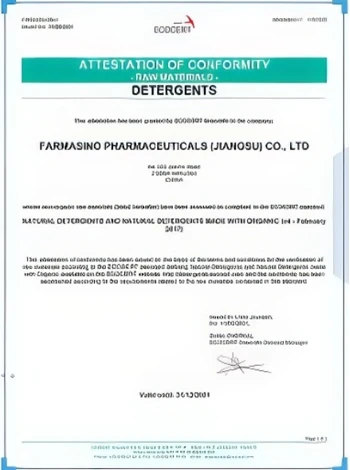



sds for sodium hydroxide pellets
Safety Data Sheet for Sodium Hydroxide Pellets
Introduction
Sodium hydroxide (NaOH), commonly known as caustic soda or lye, is a highly versatile and important chemical compound used in various industrial and laboratory applications. It is essential to understand the properties, handling, and safety precautions associated with sodium hydroxide pellets, particularly due to their corrosive nature. This article aims to provide an overview of a typical Safety Data Sheet (SDS) for sodium hydroxide pellets, focusing on the necessary information that users should be aware of.
Identification
The first section of the SDS provides the identification of the substance. Sodium hydroxide is represented by the chemical formula NaOH and has a CAS number of 1310-73-2. It is available in various forms, including flakes, pellets, and solutions. Sodium hydroxide pellets are solid, white, and odorless, with applications in manufacturing, cleaning agents, and pH regulation.
Hazard Identification
Sodium hydroxide is classified as a hazardous substance. It is classified as corrosive to metals and skin and can cause severe burns upon contact. Inhalation of sodium hydroxide dust or mist can lead to respiratory irritation. The SDS emphasizes that exposure to eyes can cause serious damage, including permanent blindness. Therefore, it is crucial to handle sodium hydroxide pellets with caution.
Composition and Ingredients
The composition section indicates that sodium hydroxide is the primary ingredient in these pellets. It may contain minute quantities of impurities, but safety data sheets generally focus on the main component due to its hazardous nature.
First Aid Measures
In the event of exposure, quick and appropriate first aid actions are vital
- Skin Contact Remove contaminated clothing immediately and rinse the affected area with plenty of water for at least 15 minutes. Seek medical attention if irritation persists. - Eye Contact Flush eyes immediately with water for at least 15 minutes while holding eyelids open. Consult an ophthalmologist without delay.
sds for sodium hydroxide pellets

- Ingestion Do not induce vomiting. Rinse the mouth with water and seek medical help immediately.
- Inhalation Move the affected individual to fresh air and provide respiratory support if necessary.
Firefighting Measures
Sodium hydroxide pellets are not flammable; however, they can react with certain substances to produce flammable hydrogen gas. In case of a fire, firefighters should wear appropriate protective equipment and use dry chemical, foam, or CO2 extinguishers. Water should be used with caution, as it can generate heat and potentially cause splattering.
Accidental Release Measures
In case of a spill or leakage, it is crucial to contain the material quickly. The affected area should be evacuated, and appropriate personal protective equipment (PPE) must be worn. Use absorbent materials to clean up the pellets and neutralize the remaining residue with an acid, if applicable.
Handling and Storage
When handling sodium hydroxide pellets, it is important to wear adequate PPE, including gloves, goggles, and protective clothing. The pellets should be stored in a cool, dry, well-ventilated area, away from incompatible materials such as acids, moisture, and organic compounds. Containers should be tightly sealed and labeled correctly.
Exposure Controls and Personal Protection
Employers should implement engineering controls to minimize exposure to sodium hydroxide. This includes local exhaust ventilation systems in work areas where pellets are handled. Employees should be trained in using personal protective equipment, emphasizing the importance of preparedness in case of spills or exposure.
Conclusion
The Safety Data Sheet for sodium hydroxide pellets provides essential information regarding the chemical's identity, hazards, handling, and emergency measures. Understanding and applying this information is crucial for anyone working with sodium hydroxide, as it ensures safe practices and minimizes the risk of accidents. Proper training and awareness are key components in maintaining a safe working environment when handling this powerful chemical.
-
Why Sodium Persulfate Is Everywhere NowNewsJul.07,2025
-
Why Polyacrylamide Is in High DemandNewsJul.07,2025
-
Understanding Paint Chemicals and Their ApplicationsNewsJul.07,2025
-
Smart Use Of Mining ChemicalsNewsJul.07,2025
-
Practical Uses of Potassium MonopersulfateNewsJul.07,2025
-
Agrochemicals In Real FarmingNewsJul.07,2025
-
Sodium Chlorite Hot UsesNewsJul.01,2025










